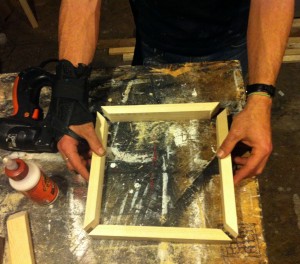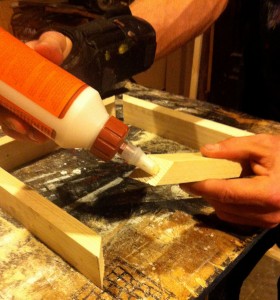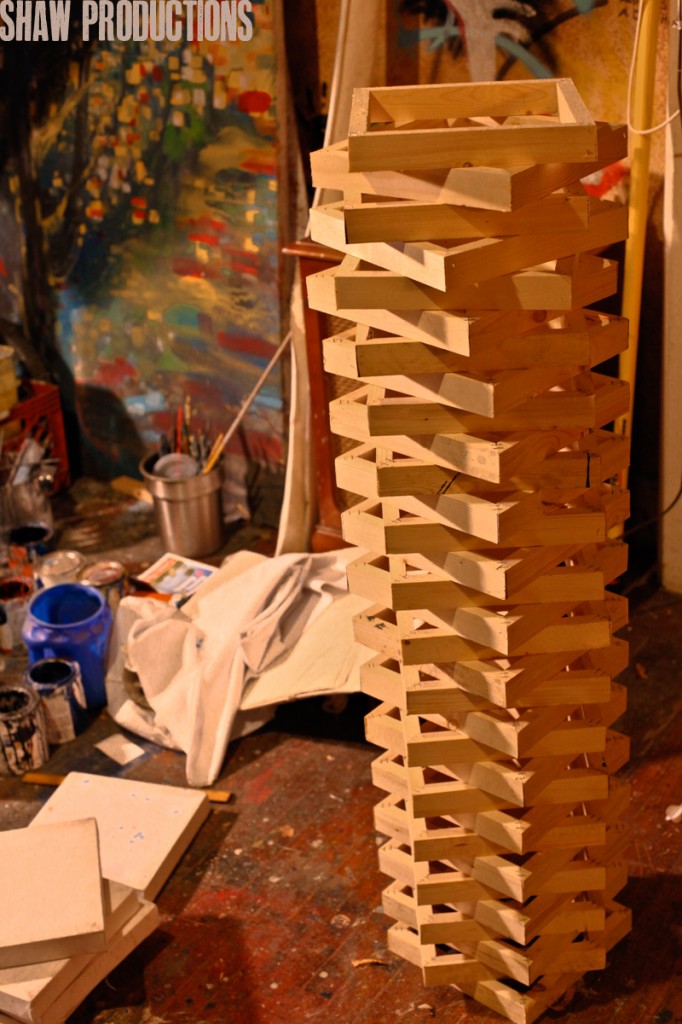
I was asked to partake in an art show helping the Springfield Art Association raise project and funding money to celebrate thier 100th year, (pretty impressive). If you know anything about this group, you would know they are one of the best and the oldest art foundations in central U.S.. To even be asked to join in is a great honor in my opinion, and I do not want to disappoint. They give lessons, host shows, and care for the old “party” house when Lincoln used to hang out and inject politics and stories into the social scene in Springfield.
The concept of this show is that 100 different artists and local celebrities were asked to make a ten inch by ten inch canvas to paint and donate. I of course can’t stay within my limits and I usually paint pretty big, so I made 100 10×10 inch canvases to fit together into a 100 inch by 100 inch composite canvas. I am thinking this piece can be auctioned off as a whole? Or perhaps as single pieces to be shared by many separated by time and distance. Hmmmm… I just don’t know yet.
I will be bring the painting to the S.A.A. on Tuesday for the show on the 20th of April, 2013. Do visit their website and check out the show if you can, and buy one of the many paintings myself or the other artists so graciously giving their time to paint for such an awesome place.
I will post the final painting after this weekend. For more info? Please go to http://www.springfieldart.org/

After all the cuts have been made, I then sand and shape the pieces to fit into as perfect a square as possible. Within a week, they will all be fastened together and then linen is stretched for the painting surface. Linen is one of the best painting surfaces in my opinion, but some may argue that.
Then they are primed and set out in the sun to dry. Painting the actual image is the last step, and usually the quickest.
Here are some pictures below of the step by step process that we use when making canvases. I can’t give all my secrets, but I can share the time and effort it takes for those wanting to learn.

After cutting 400 individual pieces of wood and sanding them to fit perfectly, they are assembled with wood glue and inch long staples to make 100 perfectly fit canvases to be merged together into one larger painting.
The hard part is getting the frames perfectly square, but it helps if your cuts are good to start. So making slow movements with the saw can make all the difference in the world for square joins.

Once the four pieces are sanded to perfection, they can be glued with wood glue and secured with just a few well placed staples. Pictured below is the best way to staple and glue the pieces together. Make sure you staple both sides and leave the staple as flush to the wood surface as possible. A staple sticking just a hair above the surface can show through the painted canvas.
There are many wood glues out there, and some are great and some not so great. I have had the best success with Gorilla Wood Glue. Retails at about six dollars. I usually get about 100 canvases out of one bottle if you conserve and not waste a drop.

It is important to secure the staples in the corners when the glue is still wet. That way when the staples and the forcing the gun down on to the frame does not crack glue already dried. Just to get the staples right, you will be twisting the canvas frame in all sorts of ways to make them all flush.
Once they are dried, secured with ample but minimal staples, and the rough joins sanded down smooth, you can start to cut the canvas out to fit the frame. I “Gallery Wrap” my canvases. This means that the canvas wraps entirely around the sides of the frame to be secured in the back. This is so you can paint the sides to match the front and the painting needs not be framed to look sharp. This is a slight trade secret of mine, so at this point I will leave you to ponder the amount of time it takes to make a single canvas.
Store bought canvas is expensive for a reason. They are all still hand made to this day. Seems that no machine can match the skill of human hands with wood and cloth, (still).

With patience and some practice, anybody can make their own canvas. A stretched canvas measuring 36 inches by 48 inches can be about 120.00 at a art supply store, but making it your self with raw materials can be about five bucks for the same size. So take some time and do it yourself… you can have a better lunch because of it.
Once the canvas is all stretched and ready to be painted I will post pictures of the process I follow to make many smaller pictures fit into a bigger more compelling piece.
Contemporary Art is some of my favorite in the wide world of Art. To make simple yet have emotional impacting statements with simple and balanced lines. This kind of project makes me enjoy what I do for a career all the more. So please return and see what I come up with for the S.A.A.’s 100th birthday bash. If you know the grounds of the S.A.A.? Then you will recognize my painting’s inspiration.

Come to the Show on the 20th of April at the Springfield Art alliance at 6 PM, located on north Fifth Street. lots of fantastic artists and people you know from radio, television, entrepreneurs and business successes will all be sharing their contribution of artwork. Worth the Saturday night out and you can see what these towers of canvas frames became.
UPDATE April 20th, 2013. Well apparently the painting will not fit in any available car… so we are scrambling to get the painting there by foot.

I noticed that among-st my Lincoln Series paintings I had approached the 100th work. So, I thought it fitting to Paint my 100th Lincoln Painting and give it to the SAA for their 100th year fund raising.
To keep it all together and flexible enough to hang easily, I had put smaller pieces of canvas on the back and stapled them together in such a way that would keep them in position, but not too heavy.
Pictured below is the back of one of the four sections. I had numbered and signed all of them individually. So when this pie3ce is broken up into different people’s hands, the paintings will always know it’s place in the grander scheme.

I like that.





